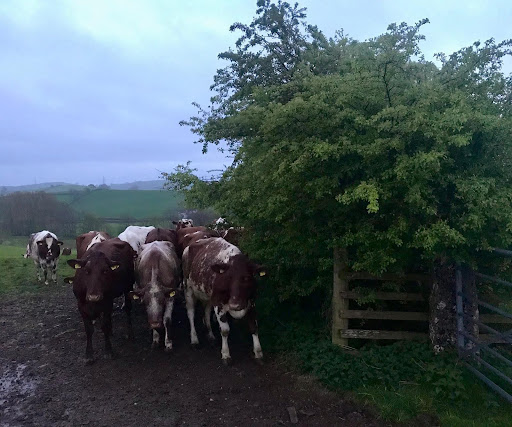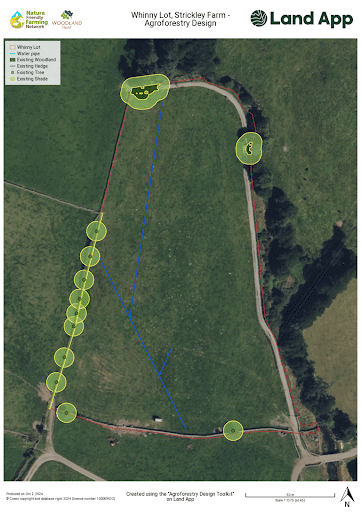“Agroforestry” – the practice of integrating trees and shrubs into agricultural systems – is increasingly important to the farming industry as awareness of climate change and the importance of resilience grows. Despite this, understanding why, how, or where to implement agroforestry systems on land can be hard to navigate, with some benefits not immediately clear.
We have teamed up with the Woodland Trust and James Robinson from the Nature-Friendly Farming Network to discuss James’ approach to integrating trees at his Strickley Farm in Cumbria, the multifunctional benefits of agroforestry, and the importance of focusing on farm resilience to reduce the impacts of extreme weather brought about by climate change.
“It was July 2022, and we had been lucky enough to be chosen as one of the host farms for the World Shorthorn Conference tour”, James tells me, when a coachload of Shorthorn breeders arrived at his farm. The weather was hot – Cumbria rarely faces 35-degree heat – and before long the discussions gave way to finding reprieve in the shade of hedgerows and James’ woodland, for both farmers and cattle alike. “On days like this, the cows are always trying to keep out of the worst of the sun, even seeking shade under the tall hedgerows by the side of the cow tracks on their way home”.

Credit: James Robinson
Though such extreme temperatures are still uncommon – this was “probably the hottest day I can remember at Strickley” – James points to an ominous scenario in 25 years. Such intense heat is predicted to become more frequent as climate change accelerates, with extreme temperatures and flooding events slowly becoming the norm by 2050. Where humans can retreat indoors to shade and air conditioning, the cattle face a far harsher reality. Extreme heat has serious health implications for cattle, both in the long and short term. A few days of reduced milk yield can be expected following heat exposure, but foot injuries from stress lines and issues with conception and pregnancy can culminate weeks and sometimes months down the line. Failing to act is not an option, James says, “we need to start thinking about how we can provide for our cows if we want them to be protected whilst they are out grazing”.
These conversations need to happen more often and with greater urgency, such as James’ panel discussion with “The Regenerative Vet” Claire Whittle at Groundswell 2024. He points to Claire’s argument that “we as farmers and vets spend a lot of time and money
planning and designing building projects around the farm yard, but rarely do we give as much thought to designing our farmed landscape to provide the same shade, shelter and protection to the cows outside”.
Whether it’s extreme cold, high winds, or ferocious heat, providing shelter is critical to the health of both livestock and the landscape in which they graze. There are more immediate benefits, too, James says. Newly planted hedgerows start to diffuse winds in their first few years, and within five to ten years they will have grown taller and wider than any protective fencing all whilst providing valuable tree browsing – both extending the grazing season compared to regular pasture as well as providing a more nutritious and balanced diet.
Agroforestry brings many wider ecological benefits. Integrating trees and shrubs into the landscape:
- improves water retention
- reduces soil erosion
- improves pasture quality,
- all whilst moderating temperature and humidity through microclimates.
Implementing these systems does take time, however, as James cautions, “If we are to mitigate the extremes of weather in 25 years’ time, we need to start planning and implementing changes now”.

Credit: James Robinson
Moving the narrative in farming beyond seeing newly planted hedges or a roundel of trees as “lost productivity” is crucial. Instead, the opposite is true, James argues. “If we took a longer-term view we would see that there is actually an increase in productive area via the three-dimensional area we have created”. Coupled with the benefits of shade, shelter and the beneficial minerals and nutrients from the new trees, then “we are really seeing a large number of positives which give us resilience in multiple areas”, a great improvement from the original field sward. Adopting this new mindset will bring considerable benefits to Strickley. Extra hedgerows have been planted to “replace those lost decades ago”, along with some 10 acres of wood pasture in strategic areas to provide extra shade and shelter when the cattle are in need.
Ultimately, by shifting the conversation away from simply productivity to instead considering resilience, the way we plan and consider the farmed landscape changes. Agroforestry is a multifaceted and effective approach to enhancing the welfare of livestock in extreme conditions, as well as mitigating some of the causes and effects of those same weather events. Whilst hopeful, the message from James and his livestock at Strickley is also urgent and clear: in choosing a more resilient future, we must also choose to act before it is too late.

Credit: James Robinson
‘Bringing more trees into the heart of farmed landscapes will help tackle the multiple pressures on land use in the UK. Agroforestry will help farm businesses adapt to the challenges of changing weather patterns providing much needed shade and shelter, enhanced water management and soil health and help maintain food production. At the same time, it will help the sector make its contribution to net zero and play an important role in nature recovery without compromising food production. The new agroforestry tool within Land App will help steer the right tree in the right place for the right reason avoiding trade-offs.’
Helen Chesshire – Lead Farming Advocate Woodland Trust.
Agroforestry in Whinny Lot Field – Preparing Strickley Farm for 2050
To assess the current state of Whinny Lot Field, James used Land App to map his current land use and to calculate the current shade in the field. Whinny Lot Field was chosen as it’s a key area for grazing his cows, however, with the current management they are exposed to both cold and hot conditions, something which is set to only get worse with climate change. Improving the shade, and taking advantage of the many other ecological benefits of agroforestry, is a key priority as Strickley’s Stewardship Agreements are coming to a close…
About the Field: Open grazing field, exposed to both heat and the cold
Current Trees in Field: 0
Trees in hedgerow: 10
Length of Hedgerow: 114m
Shade from Hedgerow: 0.023 hectares
Shade from Trees: 0.095 hectares
Current Total Shade in Field: 0.118ha

Working with the Woodland Trust and Land App, James used the new Agroforestry Designer Toolkit to quickly design and plan an agroforestry design for Whinny Lot field. By applying for capital grants and the Countryside Stewardship higher tier scheme, James’ vision for the field for 2050 includes:
- A Shelterbelt strip at the southern boundary wall
- A newly planted hedge on the western boundary, which will be allowed to grow tall and wide
- Wood pasture in-field, at a modest rate of 20-25 trees/ha.
- Species mix of poplar/willow for speed of growth, plus mountain ash and bird/wild cherry to benefit wildlife.
- Alder in wetter areas.
- Oak and hornbeam for large maturing trees
- Wych elm possible too
Using the agroforestry design tool from Land App, this was turned from an idea to a costed plan in minutes. Here’s how James’ new field would look, giving a 33% increase in shade and protection for his cattle, as well as diversifying with nut trees and improving biodiversity on his farm:
Future Plan:
Fruit, Dwarfing Rootstock: 5 (0.0020ha shade)
Nut, Hazel: 4 (0.029ha shade)
Shelter, Mixed Broadleaf Trees: 20 (0.190ha shade)
Shelter, Oak: 4 (0.322ha shade)
Shelterbelt: 134m (0.080ha shade)
Total shade: 0.759ha = 33.41 % increase

Thank you to all our partners involved in the creation of the agroforestry tool:
Shropshire Council, Trees Outside Woodland, Edd Colbert

